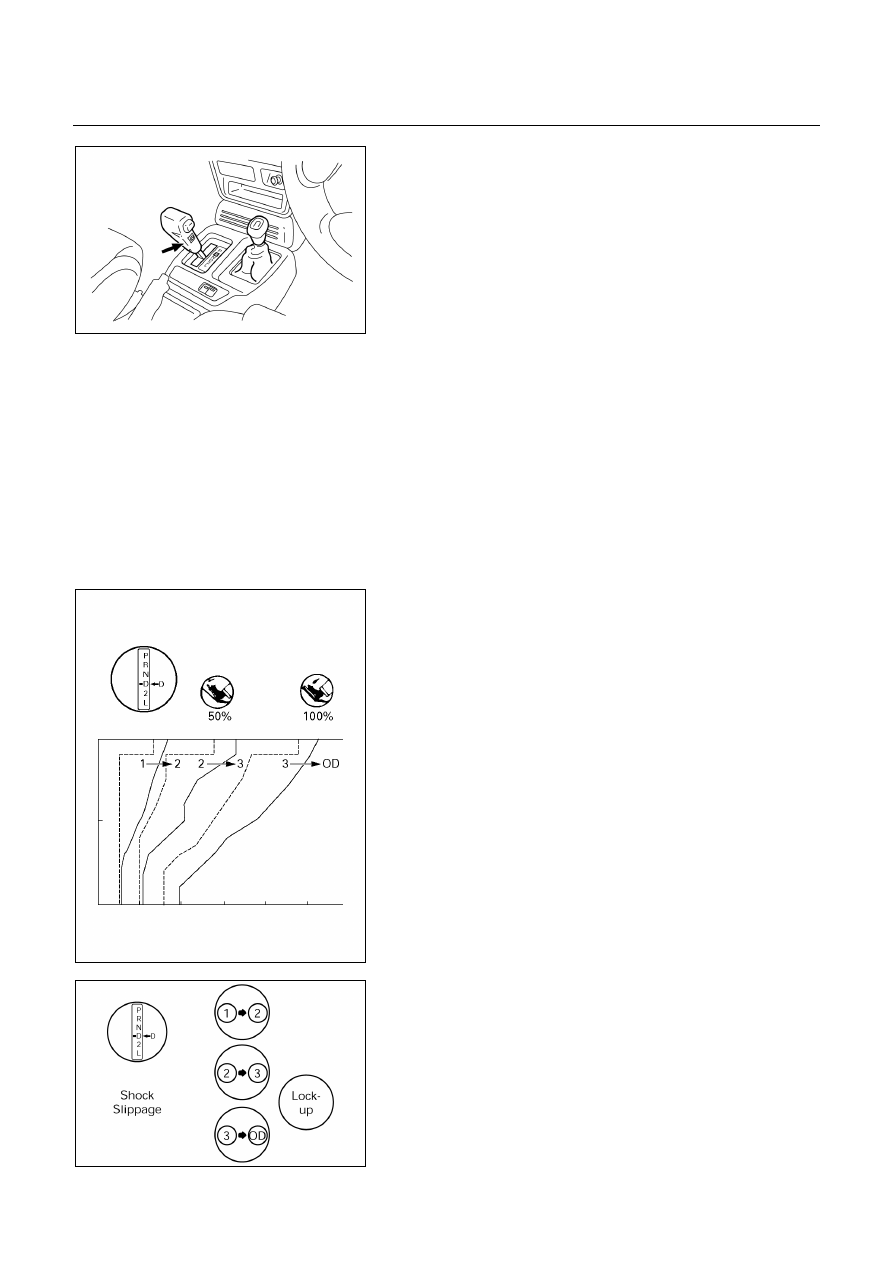Isuzu D-Max / Isuzu Rodeo (TFR/TFS). Manual — part 313

AUTOMATIC TRANSMISSION (AW30-40LE) 7A-101
F07RY00003
TIME LAG TEST
If the shift lever is shifted while the engine is idling, there
will be a certain time elapse or lag before the shock can be
felt. This is used for checking the condition of the forward
clutch, direct clutch, No.3 brake, and No.2 one-way clutch.
NOTE:
(1) Perform the test at normal operation fluid
temperature (50 – 80ººººC or 122 – 176ººººF)
(2) Be sure to allow one minute interval between
tests.
(3) Make three measurements and take the average
value.
MEASURE TIME LAG
1. Fully apply the parking brake.
2. Start the engine.
Check idling speed (A/C OFF).
3. Shift the shift lever from “N” to “D” range. Using a stop
watch, measure the time it takes from sihfting the lever
until the shock is felt.
Time lag: Less than 0.7 seconds
4. In same manner, measure the time lag for “N” → “R”.
Time lag: Less than 1.2 seconds
EVALUATION
1. If “N” → “D” time lag is longer than specified:
・Line pressure too low
・Forward clutch malfunction
・No.2 one-way clutch not operating properly
2. If “N” → “R” time lag is longer than specified:
・Line pressure too low
・Direct clutch malfunction
・No.3 brake malfunction
3. If both time lag is longer than specified:
・Line pressure too low

7A-102 AUTOMATIC TRANSMISSION (AW30-40LE)
HYDRAULIC TEST
PREPARATION
1. Warm up the transmission fluid.
2. Remove the transmission case test plug and mount the
hydraulic pressure gauge.
Oil pressure gauge: 5-8840-0093-0
NOTE:
Perform the test at normal operation fluid temperature
(50 – 80ººººC or 122 – 176ººººF).
MEASURE LINE PRESSURE
1. Fully apply the parking brake and chock the four
wheels.
2. Start the engine and check idling rpm.
3. Shift into “D” range, step down strongly on the brake
pedal with your left foot and, while manipulating the
accelerator pedal with the right foot, measure the line
pressures at the engine speeds specified in the table.
4. In the same manner, perform the test in “R” range.
Line pressure kPa (kg/cm
2
/psi)
Engine
speed
“D” range
“R” range
Idling
358 – 417
(3.6 – 4.3/
51 – 61)
588 – 686
(6.0 – 7.0/
85 – 100)
Stall
1,176 – 1,323
(12.0 – 13.5/
171 – 192)
1,607 – 1,940
(16.4 – 19.8/
233 – 282)
F07RY00004
EVALUATION
1. If the measured values at all ranges are higher than
specified:
・Pressure control solenoid defective
・Primary regulator valve defective
2. If the measured values at all ranges are lower than
specified:
・Primary regulator valve defective
・Oil pump defective
・Pressure control solenoid defective
3. If pressure is low in “D” range only:
・“D” range circuit fluid leakage
4. If pressure is low in “R” range only:
・“R” range circuit fluid leakage

AUTOMATIC TRANSMISSION (AW30-40LE) 7A-103
255RT004
F07R200019
F07RY00006
ROAD TEST
NOTE:
Perform the test at normal operation fluid temperature
(50 – 80ººººC or 122 – 176ººººF).
“D” RANGE TEST IN “NORMAL”, AND “POWER”
PATTERN RANGES
Shift into the “D” range and hold the accelerator pedal
constant at the 50% and 100% throttle valve opening
positions.
Push in one of the pattern selector buttons and check the
following:
1. 1-2, 2-3, 3-OD and lock-up, up-shifts should take place,
and shift points should conform to those shown in the
automatic shift diagram.
NOTE:
Drive the vehicle on level ground.
EVALUATION
(1) If there is no 1→2 up-shift:
・Solenoid S2 is stuck
・1-2 shift valve is stuck
(2) If there is no 2→3 up-shift:
・Solenoid S1 is stuck
・2-3 shift valve is stuck
(3) If there is no 3→OD up-shift (throttle valve opening
1/2):
・Solenoid S2 is stuck
・3-OD shift valve is stuck
(4) If the shift point is defective:
Refer to “TROUBLESHOOTING CHART” in this
section.
(5) If the lock-up is defective:
Refer to “TROUBLESHOOTING CHART” in this
section.
2. In the same manner, check the shock and slip at the 1
→2, 2→3 and 3→OD up-shifts.
EVALUATION
If the shock is excessive:
Refer to “TROUBLESHOOTING CHART” in this
section.

7A-104 AUTOMATIC TRANSMISSION (AW30-40LE)
F07RY00007
3. Run at “D” range lock-up or OD gear and check for
abnormal noise and vibration.
NOTE:
The check for the cause of abnormal noise and
vibration must be made with extreme care as it could
also be due to loss of balance in the propeller shaft,
differential, the torque converter, etc. or insufficient
bending, rigidity, etc. in the power train.
F07R200020
4. While running in “D” range, 2nd, 3rd gears and OD,
check to see that the possible kick-down vehicle speed
limits for 2→1, 3→1, 3→2, OD→3 and OD→2 kick-
downs conform to those indicated on the automatic shift
diagram.
5. Check for abnormal shock and slip at kick-down.
6. While running in “D” range, OD gear or “lock-up”, shift
to “2” and “L” ranges and check the engine braking
effect at each of these ranges.
7. Also check to see that downshift is made from 3→2 or
from OD to 3 and then to 2 immediately and that 2→1
downshift point is within the limits shown in the diagram
when tested by releasing the accelerator pedal and
shifting into position of “L” while driving in the third gear
or in overdrive.
F07RY00009
EVALUATION
(1) If there is no engine braking effect in the “2” range:
・Second coast (No.1) brake is defective.
(2) If there is no engine braking effect in the “L” range:
・First and reverse (No.3) brake is defective.
F07RY00010
(3) Also check to see that downshift is made from 3→2 or
from OD to 3 and then to 2 immediately and that 2→1
downshift point is within the limits shown in the
diagram when tested by releasing the accelerator
pedal and shifting into “L” position while driving in the
third gear or in overdrive.

Нет комментариевНе стесняйтесь поделиться с нами вашим ценным мнением.
Текст